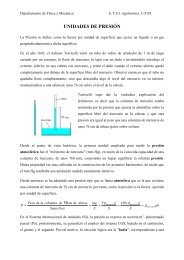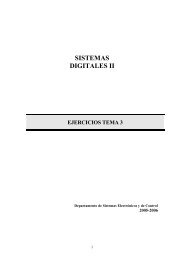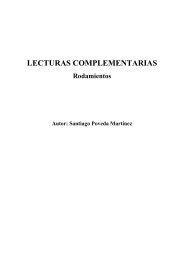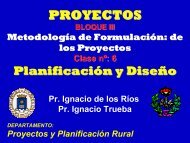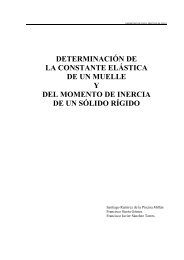TOPIC 7 essential oil - OCW UPM
TOPIC 7 essential oil - OCW UPM
TOPIC 7 essential oil - OCW UPM
Create successful ePaper yourself
Turn your PDF publications into a flip-book with our unique Google optimized e-Paper software.
Topic 7: Essential <strong>oil</strong>s<br />
7.1 Introduction<br />
7.2 Classifying <strong>essential</strong> <strong>oil</strong>s<br />
7.3 Physical properties of <strong>essential</strong> <strong>oil</strong>s<br />
7.4 Chemical properties of <strong>essential</strong> <strong>oil</strong>s<br />
7.5 Obtaining <strong>essential</strong> <strong>oil</strong>s<br />
7.6 Main uses of <strong>essential</strong> <strong>oil</strong>s<br />
7.7. References<br />
7.1 Introduction<br />
Essential <strong>oil</strong>s are compounds made up of several organic volatile substances. These may be<br />
alcohols, acetones, cetones, ethers, aldehydes, and are produced and stored in the secretion<br />
canals of plants.<br />
At room temperature they are usually liquid. Given their volatility, they can be extracted using<br />
steam distillation, though other methods exist. On the whole, they are responsible for the<br />
aromas of plants.<br />
According to AFNOR (1998), they are defined as:<br />
Products obtained from raw vegetable matter either by steam dragging or by mechanised<br />
processes (epicarpium of citrus fruits) or by dry distillation. The <strong>essential</strong> <strong>oil</strong> is later separated in<br />
the aqueous phase, using physical methods in the first two cases. They are able to undergo<br />
physical treatment without important changes in composition (re-distilling, airing…).<br />
This definition clearly establishes the differences there are between medicinal <strong>essential</strong> <strong>oil</strong>s and<br />
other aromatic substances used in pharmacy and perfumery which are commonly known as<br />
essences.<br />
Essential <strong>oil</strong>s are widely distributed in nature and are found in conifers (pine, fir), myrtaceae<br />
(eucalyptus), rutaceae (citrus spp), compounds (camomile), although the majority of plants with<br />
<strong>essential</strong> <strong>oil</strong>s are found in the labiatae (mint, lavender, thyme, rosemary) and umbelliferous<br />
(aniseed) families.<br />
They are found in different organs: roots, ryzomes (ginger), wood (camphor), leaf (eucalyptus),<br />
flowering parts (Labiatae family).<br />
Composition depends on place of origin. The habitat where the plant grows (normally warm<br />
climates have more <strong>essential</strong> <strong>oil</strong>s), the moment of harvesting, extraction methods, etc… are<br />
also important.<br />
Among the main therapeutic properties of <strong>essential</strong> <strong>oil</strong>s antiseptics stands out (for many years<br />
these spices have been added to foodstuffs not just for flavouring but to help preserve them).<br />
Other properties are: antispasmodic, expectorant, carminative, eupeptic…<br />
We should bear in mind that certain <strong>essential</strong> <strong>oil</strong>s, especially in high doses, may be toxic to the<br />
central nervous system in particular. Others, such as rue or juniper have abortive properties.<br />
Others may cause skin problems, rashes or allergies<br />
In addition to having therapeutic properties, <strong>essential</strong> <strong>oil</strong>s are widely used in the pharmaceutical,<br />
food, and perfume (especially) industries.<br />
1
7.2 Classifying <strong>essential</strong> <strong>oil</strong>s<br />
Essential <strong>oil</strong>s may be classified using different criteria: consistency, origin, and chemical nature<br />
of the main components.<br />
a. Consistency<br />
Depending on their consistency, <strong>essential</strong> <strong>oil</strong>s are classified as :<br />
-essences<br />
-balsams<br />
-resins<br />
Fluid essences are liquids which are volatile at room temperature.<br />
Balsams are natural extracts obtained from a bush or tree. They usually have a high<br />
benzoic and cynamic acid content with their corresponding esthers. They are thicker, not<br />
very volatile, and less likely to react by polymerising. Examples of balsams are copaiba<br />
balsam, Peruvian balsam, Banguy balsam, Tolu balsam, Liquid amber…<br />
Within the resin group we find a number of possible combinations and mixes:<br />
1. Resins. These are amorphous solid or semi-solid products of a complex chemical<br />
nature. They are physiological or physio-pathological in origin. Colophony, for example,<br />
is obtained by separating trementine an oleoresin. It contains abietic acid and derivates.<br />
2. Oleoresins. These are homogeneous mixes of resins and <strong>essential</strong> <strong>oil</strong>s. Trementine,<br />
for example, is obtained by making incisions in the trunk of different pine species. It<br />
contains resin (colophony) and <strong>essential</strong> <strong>oil</strong> (trementine essence) which are separated<br />
by steam drag distillation.<br />
The term oleoresin is also used to refer to vegetable extracts obtained using solvents,<br />
which should be virtually free of said solvents. They are frequently used instead of<br />
spices in foodstuffs and pharmacy because of their advantages (stability, microbiotic<br />
and chemical uniformity, and easy to add). They have the aroma of the plant in<br />
concentrated form and are highly viscous liquids or semi-solid substances (black<br />
pepper, paprika oleoresin, cloves…).<br />
3. Gum-resins. These are natural plant or tree extracts. They are a mix of gums and<br />
resins.<br />
b. Origin.<br />
Depending on their origin, <strong>essential</strong> <strong>oil</strong>s are classified as:<br />
-natural<br />
-artificial<br />
-synthetic<br />
Natural <strong>oil</strong>s are obtained straight from the plant and are not modified physically or<br />
chemically afterwards. However, they are expensive because of their limited yield.<br />
Artificial <strong>oil</strong>s are obtained using processes of enriching the essence with one or several of<br />
its components. For example, essences of rose, geranium, and jasmine are enriched with<br />
linalool, and aniseed essence with athenol.<br />
Synthetic <strong>oil</strong>s, as the name suggests, are usually produced by combining their chemically<br />
synthesised components. These are the cheapest and are thus much more commonly used<br />
as fragrance and taste enhancers (vanilla, lemon and strawberry essences…)<br />
c. Chemical nature.<br />
The total <strong>essential</strong> <strong>oil</strong> content of a plant is generally low (less than 1%). However, by<br />
extraction we obtain a highly concentrated form which is used in industrial processes. Most<br />
of these are highly complex chemical compounds. The proportion of these substances<br />
varies depending on the <strong>oil</strong>, but also on season, time of day, growing conditions, and<br />
genetics.<br />
2
The term chemotype refers to the variation in chemical composition of an <strong>essential</strong> <strong>oil</strong>,<br />
even of the same species. A chemo-type is a distinct chemical entity, different from<br />
secondary metabolites. Certain small variations in the environment, geographical location,<br />
genes…) which have little or no effect on a morphological level can, however, produce big<br />
changes in chemical phenotypes.<br />
Thyme (Thymus vulgaris) is a typical example. It has 6 different chemo-types depending on<br />
which is the main component of its essence (timol, carvacrol, linalool, geraniol, tuyanol -4,<br />
or terpineol). When this is the case, the plant is named using the name of the species<br />
followed by the main component of its chemo-type. For example, Thymus vulgaris linalool,<br />
Thymus vulgaris timol.<br />
7.3 Physical properties of <strong>essential</strong> <strong>oil</strong>s.<br />
Essential <strong>oil</strong>s are volatile and become liquid at room temperature.<br />
When distilled they are at first colourless or slightly yellowish.<br />
They are less dense than water (sassafras essence and clove essence being exceptions).<br />
They are nearly always rotational and have a high refractory index.<br />
They are soluble in alcohol and in the usual organic solvents, such as ether or chloroform,<br />
and also in high grade alcohol.<br />
They are lipo-soluble and not very soluble in water, but can be dragged using steam.<br />
7.4 Chemical properties of <strong>essential</strong> <strong>oil</strong>s (terpenoids).<br />
Essential <strong>oil</strong> components are divided into terpenoids and non-terpenoids.<br />
i. Non-terpenoids. This group contains short-chain aliphatic substances,<br />
aromatic substances, nitrogenated substances, and substances with<br />
sulphur. They are less important than terpenoids in terms of uses and<br />
applications.<br />
ii. Terpenoids. These are more important commercially and in terms of their<br />
properties.<br />
Terpenes, as we saw in topic 10, derive from isoprene units (C5) bonded in a chain.<br />
Terpenes are a type of chemical substance found in <strong>essential</strong> <strong>oil</strong>s, resins, and other<br />
aromatic plant substances, (pines, citrus fruits…). They are usually found in<br />
monoterpene <strong>oil</strong>s (C15) and diterpenes (C20). They may be aliphatic, cyclic, or<br />
aromatic.<br />
According to their function group they can be:<br />
• Alcohols (menthol, bisabolol) and phenols (timol, carvacrol)<br />
• Aldehydes (geranial, citral) and cetones (camphor, thuyone)<br />
• Esthers (bornile acetate, linalile acetate, methyl salicilate, anti-inflammatory<br />
compound similar to aspirin)<br />
• Ethers (1.8 - cineol) and peroxides (ascaridol)<br />
• Hydrocarbons (limonene, pinene α and β)<br />
3
Table one shows the functional groups for each category:<br />
Compound Functional Group Example Properties<br />
Alcohol<br />
Aldehyde<br />
Cetona<br />
Esther<br />
Menthol, geraniol<br />
Citral, citronelal<br />
Camphor, tuyona<br />
Methyl salicilate<br />
Anti--microbe, antiseptic,<br />
tonic, spasmodic<br />
Spasmodic, sedative,<br />
antiviral<br />
Mucolitic, regenerator<br />
cellular, neurotoxic<br />
Spasmodic, sedative,<br />
antifungal<br />
Ethers -C – O – C - Cineol, ascaridol Expectorant, stimulant<br />
Phenolic ether Ring – O – C Safrol, anetol, miristicine<br />
diuretic, carminative,<br />
stomach, expectorant<br />
Phenol<br />
Hydrocarbons<br />
Only contain C and<br />
H<br />
a. Monoterpenic hydrocarbons<br />
Timol, eugenol,<br />
carvacrol<br />
Pinene, limonene<br />
Antimicrobes<br />
Irritant<br />
Stimulant (imunological)<br />
Stimulant, decongestant<br />
Antiviral, antitumoral<br />
These are the commonest compounds in <strong>essential</strong> <strong>oil</strong>s, and precursors of the<br />
more complex oxidised terpenes. Their names end in –ene.<br />
Limonene, for example, is the precursor to the main components of mint<br />
essences (Mentha spp, Lamiaceae Family) such as carvone and menthol.<br />
Limonene is also found in citric plants and in dill (Anethum graveolens,<br />
Apiaceae family).<br />
Pinene α and β are also widely present in nature, especially in trementine<br />
essence of the Pinus genre (Pinaceae family).<br />
b. Alcohols<br />
Alcohols have the hydroxile group (OH) bonded to a C10<br />
skeleton. Their names end in –ol. They are highly sought after for their<br />
aroma.<br />
Linalool, for example, has two forms. R-linalool is found in roses and<br />
lavender and is the main component of Mentha arvensis. S-linalool found in<br />
lavender <strong>oil</strong> at > 5% indicates adulteration.<br />
Linalool gives tea, thyme, and cardamom leaves their taste. Menthol,<br />
another compound found in this group, is responsible for the smell and taste<br />
of mint. Mint essence may contain up to 50% of this component.<br />
Geraniol, from scented geraniums (Pelargonium spp), citronelol, from<br />
roses (Rosa gallica), borneol from rosemary, and santalol from sandalwood<br />
(Santalum album, Santalaceae family).<br />
4
c. Aldehydes<br />
d. Phenols<br />
e. Phenolic Ethers<br />
Aldehydes are highly reactive compounds. Their names end<br />
in –al. Many of them, such as those found in citrus fruits,<br />
match their respective alcohol. For example: geraniol –<br />
geranial, and citronelol – citronelal.<br />
They are found in abundance in citrus plants, and are<br />
responsible for their characteristic smell, particularly the<br />
isomers geranial (α citral) and neral (β citral) known as citral<br />
in combination (see graphic).<br />
In addition to its characteristic aroma, citral has anti-viral, antimicrobiotic,<br />
and sedative properties. But many aldehydes,<br />
including citral, cause irritation to the skin and can not be used<br />
externally.<br />
Another important group are the aromatic aldehydes, such as<br />
benzaldehyde, main ingredient of bitter almond <strong>oil</strong> and cause<br />
of their typical aroma.<br />
They are only found in a few species but are very powerful and<br />
irritating.<br />
The most important are timol and carvacrol, which are found<br />
in thyme (Thymus) and oregano (Origanus), both of the<br />
Labiatae family.<br />
Another important phenol is eugenol, which is found in many<br />
species, for example, clove essence. It is both a powerful<br />
bactericide and also anaesthetic, and is used in dentistry.<br />
These are the main components of species such as celery and<br />
parsley (apiol), aniseed (anetol), basil (metilchavicol), and<br />
estragon (estragol).<br />
Safrol is a component which is used extensively in the perfume<br />
industry and is found in the bark of the sassafras tree<br />
(Sassafras albidum Lauraceae family).<br />
5
f. Ketones<br />
g. Ethers<br />
h. Esthers<br />
These are produced by the oxidisation of alcohols and are fairly<br />
stable molecules. They end in –one. Carvone is found in Mentha<br />
spicata.<br />
Tuyone -first isolated in Tuya- (Thuja occidentalis Cupressaceae<br />
family) and pulegone are fairly toxic and should never be used<br />
during pregnancy.<br />
Tuyone is found in plants of the Artemisia genus (Artemisia<br />
absinthium with which absinthe and vermouth are made), and in<br />
salvia (Salvia officinalis).<br />
Pulegona was first isolated in Mentha pulegium.<br />
Ethers or monoterpenic oxides are reactive and unstable. One<br />
example is bisabolol oxide found in camomile (Matricaria<br />
chamomilla).<br />
Another common ether is 1.8 –cineol (also known as eucaliptol),<br />
which is the main component of eucalyptus <strong>oil</strong>. It is an expectorant<br />
and mucolitic, and the main component of cough medicines.<br />
The aroma of eucalyptus <strong>oil</strong> varies depending on 1.8 –cineol<br />
content: the <strong>oil</strong> with a high content (Eucalptus globulus) is used for<br />
medicinal purposes, whereas that with a lower content (Eucaliptus<br />
radiata) is used in aromatherapy.<br />
Most esthers are formed from a reaction of a terpenic alcohol with<br />
an acetic acid. Their aroma is characteristic of the <strong>oil</strong>s in which they<br />
are found.<br />
Lavender <strong>oil</strong>, for example, contains linalool in its esther, linalile<br />
acetate. The relative abundance of both these components is a sign<br />
of good quality.<br />
Methyl salicilate, a derivate of salicylic acid and methanol, is an<br />
anti-inflammatory compound similar to aspirin and is found in a certain<br />
type of heather (Gaultheria procumbens Ericaceae family). It is used<br />
externally in liniments.<br />
6
7.5 Industrial uses of <strong>essential</strong> <strong>oil</strong>s. Applying industrial processes to <strong>essential</strong> <strong>oil</strong>s.<br />
These are processes which are applied to <strong>essential</strong> <strong>oil</strong>s and other aromatic vegetable<br />
extracts to separate and concentrate components ready for industrial use or simply to make<br />
it easier to homogenise quality.<br />
a. Obtaining <strong>essential</strong> <strong>oil</strong>s.<br />
Steam drag distillation. The plants are placed on a perforated base or sieve at a certain<br />
distance over a distilling tank. The tank contains water at a level less than the depth of the<br />
sieve. Heating is via saturated steam when the water is heated using an in-built heater. The<br />
steam flows at a low pressure and penetrates the vegetable matter. The component parts<br />
volatilise and are then condensed in a refrigeration tube and collected in a Florentine flask<br />
where water and <strong>oil</strong> are separated because of difference in density.<br />
Pericarpium squeezing. This consists of a tray with spikes on it and a channel underneath<br />
to collect <strong>essential</strong> <strong>oil</strong>s. It is usually used for citrus fruits.<br />
Solution in fats (enfleurage). Oils are soluble in fats and high grade alcohols. A thin film of<br />
fat is placed on a glass plate and flower petals are then spread over it. The essence passes<br />
into the fat until saturated. Then the <strong>essential</strong> <strong>oil</strong> is extracted using 70% proof alcohol. It is<br />
used for flowers with a low but prized <strong>essential</strong> <strong>oil</strong> content (roses, violets, jasmine, orange<br />
blossom).<br />
Extraction using organic solvents. These penetrate the vegetable matter and dissolve<br />
substances, which are then evaporated and concentrated at low temperature. Then the<br />
solvent is eliminated, leaving only the fraction we want.<br />
When choosing a solvent we want it to dissolve all the ingredients quickly while dissolving<br />
the minimum amount of inert matter. It should have a low and even b<strong>oil</strong>ing point so that it<br />
can quickly be eliminated, though this should not cause ingredient losses. It should be<br />
chemically inert, so as not to react with the components in the <strong>oil</strong>s, non-flammable, and<br />
cheap.<br />
This ideal solvent does not exist, and petroleum ether (b<strong>oil</strong>ing point between 30 and 70<br />
degrees, flammable, easy to evaporate), benzene (which also dissolves waxes and<br />
pigments), and alcohol (soluble in water) are commonly used. Alcohol is used when there<br />
are components with a high molecular weight but which are not volatile enough.<br />
Extraction using gases in super-critical conditions. Gases (usually CO2) at a<br />
temperature and pressure above their critical points) are used. In these conditions, yield is<br />
good and we avoid changes in the components of the <strong>essential</strong> <strong>oil</strong>s. The necessary infrastructure<br />
is expensive, put has its advantages, such as the rapid elimination of the extractor<br />
gas by decompression, the absence of solvent residue, and the fact that gases are not<br />
expensive.<br />
b. Rectification.<br />
This is the most common process. It consists in fractioning in a rectification column so as to<br />
obtain portions which are then analysed separately. Those of the same quality are mixed<br />
together. On the whole, <strong>essential</strong> <strong>oil</strong>s are fractioned into three parts:<br />
-Top or light part.<br />
-Heart or middle part.<br />
-Heavy fraction.<br />
c. Fractioning.<br />
This is similar to the above but the split is more specific. Essential <strong>oil</strong>s with a 60-70% citral<br />
content are fractioned to try and eliminate other components so as to obtain 90-97% purity.<br />
7
d. Deterpening.<br />
When we eliminate terpenes (if they do not have the organo-leptic properties we want) the<br />
<strong>essential</strong> <strong>oil</strong> becomes more soluble in water, and smell and colour are concentrated.<br />
e. Dewaxing.<br />
When an <strong>essential</strong> <strong>oil</strong> is extracted by squeezing rather than steam distilling, it contains<br />
compounds such as the wax from the epicarpia of the fruit (as well as volatile terpenic<br />
fraction).<br />
f. Filtering.<br />
Raw <strong>essential</strong> <strong>oil</strong>s are filtered using filtering s<strong>oil</strong>s or other materials which retain residual<br />
water (anhydrous sodium sulphate, magnesium carbonate…). This eliminates impurities.<br />
g. Chemical reactions.<br />
To obtain new aromatic products of a better quality or value, with pleasanter sensations, we<br />
can use:<br />
-Estherification (cedar, vetiver, and mint).<br />
-Hydrogenation (citronella).<br />
-Hydration (trementine)<br />
h. Discolouring.<br />
For essences with bright colours.<br />
-Patchouli.<br />
-Bursera graveolens.<br />
-Clove.<br />
i. Washing.<br />
We wash the <strong>oil</strong> with a 1% sodium hydroxide or 10% sodium carbonate solution. This<br />
eliminates the unpleasant smell caused by the presence of acids and phenols.<br />
j. Standardising.<br />
This is not an industrial process in itself. It arises from the need to homogenise or normalise<br />
the quality of a product, because of the many variables which modify its characteristics. It is<br />
carried out to comply with industrial requirements: same characteristics whatever the origin,<br />
time of year, time of harvest…<br />
k. Isolating specific products.<br />
Some essences are commercialised to isolate some of their main components, such as<br />
eugenol (essence of clove) or cedrol (essence of cedar).<br />
7.6 Uses of <strong>essential</strong> <strong>oil</strong>s<br />
Food industry.<br />
They are used to season or condiment meats, dried and cured meats, soups, ice-cream,<br />
cheese… the most commonly used <strong>essential</strong> <strong>oil</strong>s are cilantrum, orange, and mint. They are<br />
also used in the elaboration of alcoholic and soft drinks, especially the latter. We should<br />
make specific mention here of the essences of orange, lemon, mint and fennel, which are<br />
also used in the making of sweets and chocolates.<br />
Pharmaceutical industry.<br />
They are used in toothpastes (mint and fennel essences), analgesics, and decongestant<br />
inhalers (eucalyptus). Eucalyptol is also widely used in dentistry. They are used in many<br />
medicines to neutralise unpleasant tastes (essence of orange or mint, for example).<br />
Cosmetic industry.<br />
This industry uses <strong>essential</strong> <strong>oil</strong>s to make cosmetics, soaps, scents, perfumes, and make-up.<br />
We should mention geranium, lavender, roses and patchouli essences as common<br />
examples.<br />
8
Veterinary product industry.<br />
This industry uses the <strong>essential</strong> <strong>oil</strong> of the Chenopodium ambrosoides, which is highly prized<br />
for its ascaridol (worm-killer) content. Limonene and menthol are also used to make<br />
insecticides.<br />
Industrial deodorants.<br />
At present, the use of essences to disguise the unpleasant smell of industrial products like<br />
rubber, plastic and paint is being developed. Paint manufacturers use limonene as a biodegradable<br />
solvent. Toys are also scented. In the textile industry they are used to mask<br />
unpleasant smells before and after dyeing. In paper manufacture, products such as<br />
notebooks, t<strong>oil</strong>et paper, and face wipes are scented.<br />
Tobacco industry.<br />
Requires menthol for mentholated cigarettes.<br />
Biocides and insecticides.<br />
There are certain substances such as thyme, cloves, salvia, mint, oregano, pine… with<br />
bactericidal properties. Others are insecticides:<br />
- Against ants: Mentha spicata (spearmint), Tanacetum y pennyroyal.<br />
- Against aphids: garlic, other Allium, coriander, aniseed, basil.<br />
- Against fleas: lavender, mints, lemongrass, etc.<br />
- Against flies: rue, citronella, mint, etc.<br />
- Against lice: Mentha spicata, basil, rue, etc.<br />
- Against moths: mints, Hisopo, rosemary, dill, etc.<br />
- Against coleoptera: Tanacetum, cumin, wormwood and thyme, etc.<br />
- Against cockroaches: mint, wormwood, eucalyptus, laurel, etc.<br />
- Against nematods: Tagetes, salvia, calendula, Asparagus, etc.<br />
Table 2. Some species with commercially used <strong>essential</strong> <strong>oil</strong>s.<br />
Common name Scientific name Family<br />
Ajedrea Satureja montana Labiateae<br />
Basil Ocimun basilicum Labiatae<br />
Salvia Salvia sclarea Labiatae<br />
Artemisia Artemisia vulgaris Asteraceaeae<br />
Cardamom Elettaria cardamomum Zingiberaceae<br />
Juniper Juniperus communis Cupresaceae<br />
Lavender Lavandula latifolia Labiatae<br />
Estragon Artemisia dracunculus Asteraceae<br />
Eucalyptus Eucalyptus globulus Myrtaceae<br />
Hisopo Hyssopus officinalis Labiatae<br />
Lavender Lavandula officinalis; L. angustifolia Labiatae<br />
Lavandine L. latifolia x L. angustifolia Labiatae<br />
Melissa Melissa officinalis Labiatae<br />
Mint Mentha piperita; M. spicata Labiatae<br />
Myrtle Myrtus communis Myrtaceae<br />
Oregano Origanum vulgare; O. majoricum Labiatae<br />
Rosemary Rosmarinus officinalis Labiatae<br />
Salvia Salvia officinalis Labiatae<br />
Spanish Salvia Salvia lavandulifolia Labiatae<br />
Sandalwood Santalum album Santalaceae<br />
Thyme Thymus vulgaris Labiatae<br />
Ylang – Ylang Cananga odorata Annonaceae<br />
9
7.7. References<br />
Bruneton, J. (2001). Farmacognosia. Fitoquímica. Plantas Medicinales. 2nd Ed. Zaragoza:<br />
Acribia S. A.<br />
Las Plantas de Extractos. Bases para un Plan de Desarrollo del Sector. Fundación Alfonso<br />
Martín Escudero. Madrid, 1999.<br />
Pengelly, A. (1996). The constituents of Medicinal Plants. 2 nd Ed. Cabi Publishing, U. K.<br />
Publicaciones de la Cátedra de Farmacognosia y productos naturales. Facultad de Química,<br />
Universidad de la República Oriental del Uruguay.<br />
Van Ginkel, A. (2003). Apuntes del Máster y Diplomatura de posgrado de la UAB “Plantas<br />
Medicinales y Fitoterapia. Módulo 2. Cultivo de plantas medicinales. Tecnología y Producción.”<br />
10




